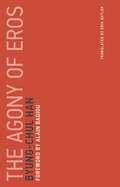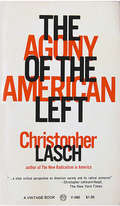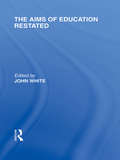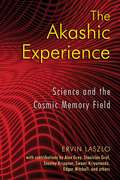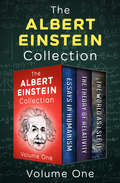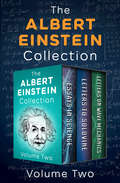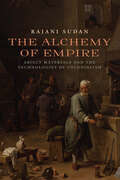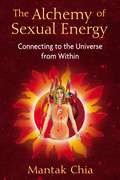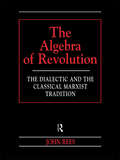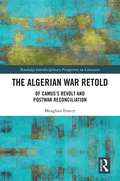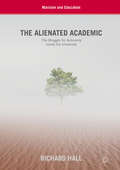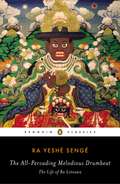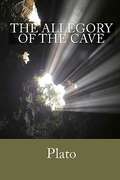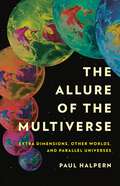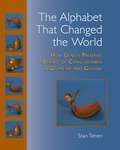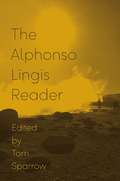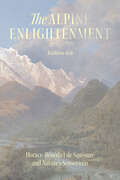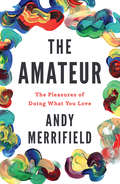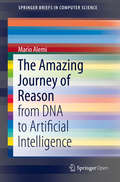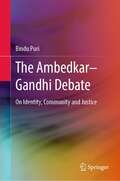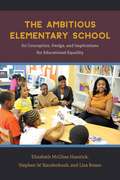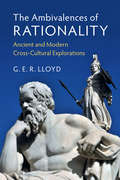- Table View
- List View
The Agony of Eros (Untimely Meditations #1)
by Byung-Chul HanAn argument that love requires the courage to accept self-negation for the sake of discovering the Other.Byung-Chul Han is one of the most widely read philosophers in Europe today, a member of the new generation of German thinkers that includes Markus Gabriel and Armen Avanessian. In The Agony of Eros, a bestseller in Germany, Han considers the threat to love and desire in today's society. For Han, love requires the courage to accept self-negation for the sake of discovering the Other. In a world of fetishized individualism and technologically mediated social interaction, it is the Other that is eradicated, not the self. In today's increasingly narcissistic society, we have come to look for love and desire within the “inferno of the same.” Han offers a survey of the threats to Eros, drawing on a wide range of sources—Lars von Trier's film Melancholia, Wagner's Tristan und Isolde, Fifty Shades of Grey, Michel Foucault (providing a scathing critique of Foucault's valorization of power), Martin Buber, Hegel, Baudrillard, Flaubert, Barthes, Plato, and others. Han considers the “pornographication” of society, and shows how pornography profanes eros; addresses capitalism's leveling of essential differences; and discusses the politics of eros in today's “burnout society.” To be dead to love, Han argues, is to be dead to thought itself. Concise in its expression but unsparing in its insight, The Agony of Eros is an important and provocative entry in Han's ongoing analysis of contemporary society.This remarkable essay, an intellectual experience of the first order, affords one of the best ways to gain full awareness of and join in one of the most pressing struggles of the day: the defense, that is to say—as Rimbaud desired it—the “reinvention” of love.—from the foreword by Alain Badiou
The Agony of the American Left
by Christopher LaschFive long essays by an American historian, the author of The New Radicalism in America (1965). Under the rubric of "the collapse of mass-based radical movements," Lasch examines the decline of populism, the disintegration of the American socialist party, and the weaknesses of black nationalism. Also included is a history of the Congress for Cultural Freedom and a discussion of the '60's revival of ideological controversy.
The Aims of Education Restated (International Library of the Philosophy of Education Volume 22)
by John WhiteJohn White's study is the most substantial work on what the aims of education should be since Whitehead's Aims of Education of 1929. It draws on material not only from schools and colleges, but also from the broader educative or miseducative nature of the 'ethos' of society and some of its major institutions. Sifting the different views about aims which are now prevalent and circulating in the world of education, he integrates the more defensible of them into an articulated set of positive recommendations. The study takes a broadly philosophical and non-technical stand; it is written to help practitioners orient themselves in what is often bewildering territory, at a time when the question of what the aims of education ought to be has acquired a new urgency for politicians and educational administrators, as well as for those directly involved in educational institutions, head teachers and their staff.
The Aims of Higher Education: Problems of Morality and Justice
by Harry Brighouse Michael McPhersonIn this book, philosopher Harry Brighouse and Spencer Foundation president Michael McPherson bring together leading philosophers to think about some of the most fundamental questions that higher education faces. Looking beyond the din of arguments over how universities should be financed, how they should be run, and what their contributions to the economy are, the contributors to this volume set their sights on higher issues: ones of moral and political value. The result is an accessible clarification of the crucial concepts and goals we so often skip over—even as they underlie our educational policies and practices. The contributors tackle the biggest questions in higher education: What are the proper aims of the university? What role do the liberal arts play in fulfilling those aims? What is the justification for the humanities? How should we conceive of critical reflection, and how should we teach it to our students? How should professors approach their intellectual relationship with students, both in social interaction and through curriculum? What obligations do elite institutions have to correct for their historical role in racial and social inequality? And, perhaps most important of all: How can the university serve as a model of justice? The result is a refreshingly thoughtful approach to higher education and what it can, and should, be doing.
The Akashic Experience: Science and the Cosmic Memory Field
by Ervin LaszloFirsthand testimonies by 20 leaders in culture and science of their interactions with the Akashic field • Provides important evidence for the authenticity of nonmaterial contact that human beings have with each other and with the cosmos • Demonstrates that the increasing frequency and intensity of these experiences is evidence of a widespread spiritual resurgence • Includes contributions by Alex Grey, Stanislav Grof, Stanley Krippner, Swami Kriyananda, Edgar Mitchell, and others Knowing or feeling that we are all connected to each other and to the cosmos by more than our eyes and ears is not a new notion but one as old as humanity. Traditional indigenous societies were fully aware of nonmaterial connections and incorporated them into their daily life. The modern world, however, continues to dismiss and even deny these intangible links--taking as real only that which is physically manifest or proved “scientifically.” Consequently our mainstream culture is spiritually impoverished, and the world we live in has become disenchanted. In The Akashic Experience, 20 leading authorities in fields such as psychiatry, physics, philosophy, anthropology, natural healing, near death experience, and spirituality offer firsthand accounts of interactions with a cosmic memory field that can transmit information to people without having to go through the senses. Their experiences with the Akashic field are now validated and supported by evidence from cutting-edge sciences that shows that there is a cosmic memory field that contains all information--past, present, and future. The increasing frequency and intensity of these Akashic experiences are an integral part of a large-scale spiritual resurgence and evolution of human consciousness that is under way today.
The Albert Einstein Collection Volume One: Essays in Humanism, The Theory of Relativity, and The World As I See It
by Albert EinsteinThree captivating volumes reveal how Einstein viewed both the physical universe and the everyday world in which he lived. A century after his theory of general relativity shook the foundations of the scientific world, Albert Einstein&’s name is still synonymous with genius. This collection is an introduction to one of the world&’s greatest minds.Essays in Humanism Nuclear proliferation, Zionism, and the global economy are just a few of the insightful and surprisingly prescient topics scientist Albert Einstein discusses in this volume of collected essays from between 1931 and 1950. With a clear voice and a thoughtful perspective on the effects of science, economics, and politics in daily life, Einstein&’s essays provide an intriguing view inside the mind of a genius as he addresses the philosophical challenges presented during the turbulence of the Great Depression, World War II, and the dawn of the Cold War.The Theory of Relativity and Other Essays E=mc2 may be Einstein&’s most well-known contribution to modern science. Now, on the one-hundredth anniversary of the theory of general relativity, discover the thought process behind this famous equation. In this collection of his seven most important essays on physics, Einstein guides his reader through the many layers of scientific theory that formed a starting point for his discoveries. By both supporting and refuting the theories and scientific efforts of his predecessors, he reveals the origins and meaning of such significant topics as physics and reality, the fundamentals of theoretical physics, the common language of science, the laws of science and of ethics, and an elementary derivation of the equivalence of mass and energy. This remarkable collection, authorized by the Albert Einstein archives, allows the non-scientist to understand not only the significance of Einstein&’s masterpiece, but also the brilliant mind behind it.The World As I See It Authorized by the Albert Einstein Archives, this is a fascinating collection of observations about life, religion, nationalism, and a host of personal topics that engaged the intellect of one of the world&’s greatest minds. In the aftermath of World War I, Einstein writes about his hopes for the League of Nations, his feelings as a German citizen about the growing anti-Semitism and nationalism of his country, and his opinions about the current affairs of his day. In addition to these political perspectives, The World As I See It reveals the idealistic, spiritual, and witty side of this great intellectual as he approaches topics including &“Good and Evil,&” &“Religion and Science,&” &“Active Pacifism,&” &“Christianity and Judaism,&” and &“Minorities.&” Including letters, speeches, articles and essays written before 1935, this collection offers a complete portrait of Einstein as a humanitarian and as a human being trying to make sense of the changing world around him.This authorized ebook features new introductions by Neil Berger and an illustrated biography of Albert Einstein, which includes rare photos and never-before-seen documents from the Albert Einstein Archives at the Hebrew University of Jerusalem.
The Albert Einstein Collection Volume Two: Essays in Science, Letters to Solovine, and Letters on Wave Mechanics
by Albert EinsteinFrom revealing, personal letters to brilliant essays on the nature of science, these three volumes demonstrate the breadth of Einstein&’s thought. The man who became famous for conceiving of the equation E=mc2 kept his mind sharp through stimulating correspondence and applied his intellectual acuity to a number of important scientific issues. The second volume of the Albert Einstein Collection offers a fascinating window into how he developed his ideas. Essays in Science: In these sixteen essays, written at the height of his intellectual powers, Einstein sets out his views on scientific knowledge, its relationship to human experience, and the underlying principles of any scientific pursuit. He discusses his own work in theoretical physics and its basis in field theory, as well as the many achievements of other scientific thinkers—including Johannes Kepler, Isaac Newton, James Clerk Maxwell, Max Planck, Niels Bohr, and others. Letters to Solovine: This collection of personal letters from Einstein to his longtime friend and translator Maurice Solovine offers a rare glimpse into the evolution of his thought, as well as a revealing portrait of the man himself. Spanning Einstein&’s career and ranging from philosophical discussion to personal gossip, these letters are presented in English translation alongside the German text, with facsimiles of the original letters also included. Letters on Wave Mechanics: In this stirring collection of correspondence, four of the twentieth century&’s greatest minds—H. A. Lorentz, Max Planck, Erwin Schrödinger, and Albert Einstein—discuss, debate, and refine Schrödinger&’s then-nascent theory of wave mechanics. As the physicist Karl Przibram states in his foreword to this edition, &“little needs to be added to the letters; they speak for themselves. Apart from their essential content, they reveal something of the personalities of the four men of genius.&”
The Alchemy of Empire: Abject Materials and the Technologies of Colonialism
by Rajani SudanNamed 'Top 6' South Asia studies publications of 2016 by the British Association for South Asian StudiesThe Alchemy of Empire unravels the non-European origins of Enlightenment science. Focusing on the abject materials of empire-building, this study traces the genealogies of substances like mud, mortar, ice, and paper, as well as forms of knowledge like inoculation. Showing how East India Company employees deployed the paradigm of alchemy in order to make sense of the new worlds they confronted, Rajani Sudan argues that the Enlightenment was born largely out of Europe’s (and Britain’s) sense of insecurity and inferiority in the early modern world. Plumbing the depths of the imperial archive, Sudan uncovers the history of the British Enlightenment in the literary artifacts of the long eighteenth century, from the correspondence of the East India Company and the papers of the Royal Society to the poetry of Alexander Pope and the novels of Jane Austen.
The Alchemy of Sexual Energy: Connecting to the Universe from Within
by Mantak ChiaTaoist techniques for replenishing our internal energy with universal cosmic energy • Shows how to transform excess sexual energy (Ching Chi) into self-healing energy • Presents advanced Cosmic Healing Chi Kung practices, which gather the limitless resources of Cosmic Chi for healing • Explains how opening of the three tan tiens to the six directions allows personal consciousness to connect directly to higher sources of energy Taoists consider our sexual energy to be the creative force that we can use to regenerate the body’s internal energy, but we must learn how to harness excess sexual energy and transform it into chi, or life-force energy. When we circulate the sexual energy in the Microcosmic Orbit--a continuous energy loop that runs up the spine and down the front of the body--we transform it into self-healing energy that can be stored in the organs and the three tan tiens: energy centers in the brain, the heart center, and the lower abdomen. The Alchemy of Sexual Energy builds upon Microcosmic Orbit practices discussed in Healing Light of the Tao. The more we open the flow of our internal energy the more capable we are of connecting to the cosmic energy that exists outside ourselves in the universe. By learning to open the three tan tiens to the six directions, the Taoist practitioner combines mind power with extension of chi to draw cosmic energy into the body. This energy, too, can be stored in the three tan tiens and used as needed for healing. When we learn to flow in this way with the energy of the Tao, life ceases to be a struggle.
The Algebra of Revolution: The Dialectic and the Classical Marxist Tradition (Revolutionary Studies)
by John ReesThe Algebra of Revolution is the first book to study Marxist method as it has been developed by the main representatives of the classical Marxist tradition, namely Marx and Engels, Luxembourg, Lenin, Lukacs, Gramsci and Trotsky. This book provides the only single volume study of major Marxist thinkers' views on the crucial question of the dialectic, connecting them with pressing contemporary, political and theoretical questions. John Rees's The Algebra of Revolution is vital reading for anyone interested in gaining a new and fresh perspective on Marxist thought and on the notion of the dialectic.
The Algerian War Retold: Of Camus’s Revolt and Postwar Reconciliation (Routledge Interdisciplinary Perspectives on Literature)
by Meaghan EmeryThe Algerian War Retold: Of Camus’s Revolt and Postwar Reconciliation focuses on specific aspects of Albert Camus’s ethical thought through a study of his writings in conjunction with late 20th- and early 21st-century works written by Franco-Maghrebi authors on the topic of the Algerian War (1954-1962). It combines historical inquiry with literary analysis in order to examine the ways in which Camus’s concept of revolt -- in his novels, journalistic writing, and philosophical essays -- reverberates in productions pertaining to that war. Following an examination of Sartre’s and Camus’s debate over revolution and violence, one that in another iteration asks whether FLN-sponsored terrorism was justified, The Algerian War Retold uncovers how today’s writers have adopted paradigms common to both Sartre’s and Camus’s oeuvres when seeking to break the silence and influence France’s national narrative. In the end, it attempts to answer the critical questions raised by literary acts of violence, including whether Camusian ethics ultimately lead to justice for the Other in revolt. These questions are particularly poignant in view of recent presidential declarations in response to years of active pressure applied by associations and other citizens’ groups, prompting the French government to acknowledge the state’s abandonment of the harkis, condemn the repression of peaceful protest, and recognize the French army’s systematic use of torture in Algeria.
The Alienated Academic: The Struggle for Autonomy Inside the University (Marxism and Education)
by Richard HallHigher education is increasingly unable to engage usefully with global emergencies, as its functions are repurposed for value. Discourses of entrepreneurship, impact and excellence, realised through competition and the market, mean that academics and students are increasingly alienated from themselves and their work. This book applies Marx’s concept of alienation to the realities of academic life in the Global North, in order to explore how the idea of public education is subsumed under the law of value. In a landscape of increased commodification of higher education, the book explores the relationship between alienation and crisis, before analysing how academic knowledge, work, identity and life are themselves alienated. Finally, it argues that through indignant struggle, another world is possible, grounded in alternative forms of organising life and producing socially-useful knowledge, ultimately requiring the abolition of academic labour. This pioneering work will be of interest and value to all those working in the higher education sector, as well as those concerned with the rise of neoliberalism and marketization within universities.
The Alienated Subject: On the Capacity to Hurt
by James A. TynerA timely and provocative discussion of alienation as an intersectional category of life under racial capitalism and white supremacy From the divisiveness of the Trump era to the Covid-19 pandemic, alienation has become an all-too-familiar contemporary concept. In this groundbreaking book, James A. Tyner offers a novel framework for understanding the alienated subject, situating it within racial capitalism and white supremacy. Directly addressing current economic trends and their rhetoric of xenophobia, discrimination, and violence, The Alienated Subject exposes the universal whitewashing of alienation. Drawing insight from a variety of sources, including Marxism, feminism, existentialism, and critical race theory, Tyner develops a critique of both the liberal subject and the alienated subject. Through an engagement with the recent pandemic and the Black Lives Matter movement, he demonstrates how the alienated subject is capable of both compassion and cruelty; it is a sadomasochist. Tyner goes on to emphasize the importance of the particular places we find the alienated subject and how the revolutionary transformation of alienation is inherently a spatial struggle. Returning to key interlocutors from Sartre to Fromm, he examines political notions of distance and the spatial practices of everyday life as well as the capitalist conditions that give rise to the alienated subject.For Tyner, the alienated subject is not the iconic, romanticized image of Marx&’s proletariat. Here he calls for an affirmation of love as a revolutionary concept, necessary for the transformation of a society marred by capitalism into an emancipated, caring society conditioned by socially just relations.
The Alignment Problem: Machine Learning And Human Values
by Brian ChristianA jaw-dropping exploration of everything that goes wrong when we build AI systems and the movement to fix them. Today’s “machine-learning” systems, trained by data, are so effective that we’ve invited them to see and hear for us—and to make decisions on our behalf. But alarm bells are ringing. Recent years have seen an eruption of concern as the field of machine learning advances. When the systems we attempt to teach will not, in the end, do what we want or what we expect, ethical and potentially existential risks emerge. Researchers call this the alignment problem. Systems cull résumés until, years later, we discover that they have inherent gender biases. Algorithms decide bail and parole—and appear to assess Black and White defendants differently. We can no longer assume that our mortgage application, or even our medical tests, will be seen by human eyes. And as autonomous vehicles share our streets, we are increasingly putting our lives in their hands. The mathematical and computational models driving these changes range in complexity from something that can fit on a spreadsheet to a complex system that might credibly be called “artificial intelligence.” They are steadily replacing both human judgment and explicitly programmed software. In best-selling author Brian Christian’s riveting account, we meet the alignment problem’s “first-responders,” and learn their ambitious plan to solve it before our hands are completely off the wheel. In a masterful blend of history and on-the ground reporting, Christian traces the explosive growth in the field of machine learning and surveys its current, sprawling frontier. Readers encounter a discipline finding its legs amid exhilarating and sometimes terrifying progress. Whether they—and we—succeed or fail in solving the alignment problem will be a defining human story. The Alignment Problem offers an unflinching reckoning with humanity’s biases and blind spots, our own unstated assumptions and often contradictory goals. A dazzlingly interdisciplinary work, it takes a hard look not only at our technology but at our culture—and finds a story by turns harrowing and hopeful.
The All-Pervading Melodious Drumbeat: The Life of Ra Lotsawa
by Ra Yeshe SengeThe story of Tibet&’s notorious master of Buddhist sorcery—translated for the first time into EnglishAn essential sacred text of Tibetan Buddhism, The All-Pervading Melodious Drumbeat tells the wondrous story of Ra Lotsawa Dorjé Drak. Though he was canonized as a saint and a fully enlightened buddha, the eleventh-century Ra Lotsawa&’s life story presents a darker path than those taken by Siddhartha Gautama and Milarepa. Viewed by some as a murderous villain and by others as a liberator of human suffering, Ra Lotsawa used his formidable power and magical abilities to defeat his rivals, accumulate wealth, and amass a devoted following. His life offers a rare view into the often overlooked roles of magic and sorcery in the Buddhist tradition. Despite this sinister legacy, his fame also rests on an illustrious career as a translator of Buddhist scriptures, through which he helped spark a renaissance of Buddhism in Tibet. This spirited new translation gives readers in English their first opportunity to encounter one of the most colorful and memorable figures in Tibetan Buddhist history.For more than sixty-five years, Penguin has been the leading publisher of classic literature in the English-speaking world. With more than 1,500 titles, Penguin Classics represents a global bookshelf of the best works throughout history and across genres and disciplines. Readers trust the series to provide authoritative texts enhanced by introductions and notes by distinguished scholars and contemporary authors, as well as up-to-date translations by award-winning translators.
The Allegory of the Cave
by PlatoPlato's Allegory of the Cave is one of the most famous pieces of philosophical literature. This edition was translated by Benjamin Jowett and has been completely revised and updated. Proofreader's Note: There are some punctuation errors that were left intact because they were present in the print copy.
The Allure of the Multiverse: Extra Dimensions, Other Worlds, and Parallel Universes
by Paul Halpern&“A rich and rewarding history of one of the most astounding ideas in physics and astronomy&” (Marcia Bartusiak) – that the universe we know isn&’t the only one Our books, our movies—our imaginations—are obsessed with extra dimensions, alternate timelines, and the sense that all we see might not be all there is. In short, we can&’t stop thinking about the multiverse. As it turns out, physicists are similarly captivated. In The Allure of the Multiverse, physicist Paul Halpern tells the epic story of how science became besotted with the multiverse, and the controversies that ensued. The questions that brought scientists to this point are big and deep: Is reality such that anything can happen, must happen? How does quantum mechanics &“choose&” the outcomes of its apparently random processes? And why is the universe habitable? Each question quickly leads to the multiverse. Drawing on centuries of disputation and deep vision, from luminaries like Nietzsche, Einstein, and the creators of the Marvel Cinematic Universe, Halpern reveals the multiplicity of multiverses that scientists have imagined to make sense of our reality. Whether we live in one of many different possible universes, or simply the only one there is, might never be certain. But Halpern shows one thing for sure: how stimulating it can be to try to find out.
The Alphabet That Changed the World: How Genesis Preserves a Science of Consciousness in Geometry and Gesture
by Stan TenenRabbinic tradition asserts that every letter of every word of the Torah is a word in itself. Author Stan Tenen demonstrates that each letter is also a hand gesture, and it is at this level that Hebrew forms a natural universal language. All people, including children before they speak and people without sight, make natural use of these gestures. In The Alphabet That Changed the World, Tenen examines the Hebrew text of Genesis and its relationship to the alphabet. He shows how each letter is both concept and gesture, with the form of the gesture matching the function of the concept. There is thus an implicit relationship between the physical world of function and the conscious world of concept. Using over 200 color illustrations, Tenen demonstrates geometric metaphor as the best framework for understanding the deepest meaning of the text. Such geometry models embryonic growth and self-organization and the core of many healing and meditative practices. Many subjects in contemporary science were derived from the methods and means available to the ancients; The Alphabet That Changed the World makes this authoritative recovery of the &“science of consciousness&” in Genesis accessible for the first time to the contemporary reading public.
The Alphonso Lingis Reader
by Alphonso LingisA selection of the writings of Alphonso Lingis, showcasing a unique blend of travelogue, cultural anthropology, and philosophy Alphonso Lingis is arguably the most intriguing American philosopher of the past fifty years—a scholar of transience, someone who has visited and revisited more than one hundred countries and has woven this itinerary into his writing and allowed it to give form to his thinking. This book assembles a representative selection of Lingis&’s work to give readers a thorough sense of his methodology and vision, the diversity of his subject matter, and the unity of his thought.Lingis&’s writing evinces the many kinds of knowledge and subtle forces circulating through human communities and their environments. His unique style blends travel writing, cultural anthropology, and personal accounts of his innumerable experiences as an active participant in the adventures and relationships that fill his life. Drawing from countless articles, essays, and interviews published over fifty years, editor Tom Sparrow chose works that follow Lingis&’s engaging, often intimate reflections on the body in motion and the myriad influences—social, cultural, aesthetic, libidinal, physical, mythological—that shape and animate it as it moves through the world, among people and places both foreign and domestic, familiar and unknown. In a substantial Introduction, Sparrow provides a biographical, critical, intellectual, and cultural context for reading and appreciating Alphonso Lingis&’s work.An extended encounter with the singular philosopher, The Alphonso Lingis Reader conducts us through Lingis&’s early writing on phenomenology to his hybrid studies fusing philosophy, psychoanalysis, anthropology, communication theory, aesthetics, and other disciplines, to his original, inspired arguments about everything from knowledge to laughter to death.
The Alpine Enlightenment: Horace-Bénédict de Saussure and Nature’s Sensorium (The Life of Ideas)
by Kathleen KeteA study of the experience of nature in the eighteenth century based on the life of Horace-Bénédict de Saussure (1740–99). In The Alpine Enlightenment, historian Kathleen Kete takes us into the world of the Genevan geologist, physicist, inventor, and mountaineer Horace-Bénédict de Saussure. During his prodigious climbs into the upper ranges of the Alps, Saussure focused intensely on the natural phenomena he encountered—glaciers, crevasses, changes in the weather, and shifts in the color of the sky—and he described with great precision what he saw, heard, and touched. Kete uses Saussure’s evocative writings, which emphasized above all physical engagement with the earth, to uncover not just how people during the Enlightenment thought about nature, but how they experienced it. As Kete shows, Saussure thought with and through his body: he harnessed his senses to understand the forces that shaped the world around him. In so doing, he offered a vision of nature as worthy of respect independent of human needs, anticipating present-day concerns about the environment and our shared place within it.
The Amateur: The Pleasures of Doing What You Love
by Andy MerrifieldA passionate attack on the tyranny of expertsModern life is being destroyed by experts and professionals. We have lost our amateur spirit and need to rediscover the radical and liberating pleasure of doing things we love.In The Amateur, thinker Andy Merrifield shows us how the many spheres of our lives—work, knowledge, cities, politics—have fallen into the hands of box tickers, bean counters and rule followers. In response, he corrals a team of independent thinkers, wayward poets, dabblers and square pegs who challenge the accepted wisdom. Such figures as Charles Baudelaire, Dostoevsky, Edward Said, Guy Debord, Hannah Arendt and Jane Jacobs show us the way. As we will see the amateur takes risks, thinks the unthinkable and seeks independence—and changes the world.The Amateur is a passionate manifesto for the liberated life, one that questions authority and reclaims the non–team player as a radical hero of our times.
The Amazing Journey of Reason: from DNA to Artificial Intelligence (SpringerBriefs in Computer Science)
by Mario AlemiThis Open Access book explores questions such as why and how did the first biological cells appear? And then complex organisms, brains, societies and –now– connected human societies? Physicists have good models for describing the evolution of the universe since the Big Bang, but can we apply the same concepts to the evolution of aggregated matter –living matter included? The Amazing Journey analyzes the latest results in chemistry, biology, neuroscience, anthropology and sociology under the light of the evolution of intelligence, seen as the ability of processing information. The main strength of this book is using just two concepts used in physics –information and energy– to explain: The emergence and evolution of life: procaryotes, eukaryotes and complex organismsThe emergence and evolution of the brainThe emergence and evolution of societies (human and not)Possible evolution of our "internet society" and the role that Artificial Intelligence is playing
The Ambedkar–Gandhi Debate: On Identity, Community and Justice
by Bindu PuriThis book reconstructs the philosophical issues informing the debate between the makers of modern India: Ambedkar and Gandhi. At one level, this debate was about a set of different but interconnected issues: caste and social hierarchies, untouchability, Hinduism, conversion, temple entry, and political separatism. The introduction to this book provides a brief overview of the engagements and conflicts in Gandhi and Ambedkar's central arguments. However, at another level, this book argues that the debate can be philosophically re-interpreted as raising their differences on the following issues: The nature of the self,The relationship between the individual self and the community,The appropriate relationship between the constitutive encumbrances of the self and a conception of justice,The relationship between memory, tradition, and self-identity. Ambedkar and Gandhi’s contrary conceptions of the self, history,itihaas, community and justice unpack incommensurable world views. These can be properly articulated only as very different answers to questions about the relationship between the present and the past. This book raises these questions and also establishes the link between the Ambedkar--Gandhi debate in the early 20th century and its re-interpretation as it resonates in the imagination and writing of marginalized social groups in the present times.
The Ambitious Elementary School: Its Conception, Design, and Implications for Educational Equality
by Lisa Rosen Stephen W. Raudenbush Elizabeth McGhee HassrickThe challenge of overcoming educational inequality in the United States can sometimes appear overwhelming, and great controversy exists as to whether or not elementary schools are up to the task, whether they can ameliorate existing social inequalities and initiate opportunities for economic and civic flourishing for all children. This book shows what can happen when you rethink schools from the ground up with precisely these goals in mind, approaching educational inequality and its entrenched causes head on, student by student. Drawing on an in-depth study of real schools on the South Side of Chicago, Elizabeth McGhee Hassrick, Stephen W. Raudenbush, and Lisa Rosen argue that effectively meeting the challenge of educational inequality requires a complete reorganization of institutional structures as well as wholly new norms, values, and practices that are animated by a relentless commitment to student learning. They examine a model that pulls teachers out of their isolated classrooms and places them into collaborative environments where they can share their curricula, teaching methods, and assessments of student progress with a school-based network of peers, parents, and other professionals. Within this structure, teachers, school leaders, social workers, and parents collaborate to ensure that every child receives instruction tailored to his or her developing skills. Cooperating schools share new tools for assessment and instruction and become sites for the training of new teachers. Parents become respected partners, and expert practitioners work with researchers to evaluate their work and refine their models for educational organization and practice. The authors show not only what such a model looks like but the dramatic results it produces for student learning and achievement. The result is a fresh, deeply informed, and remarkably clear portrait of school reform that directly addresses the real problems of educational inequality.
The Ambivalences of Rationality: Ancient and Modern Cross-Cultural Explorations
by G.E.R. LloydIs rationality a well-defined human universal such that ideas and behaviour can everywhere be judged by a single set of criteria? Or are the rational and the irrational simply cultural constructs? This study provides an alternative to both options. The universalist thesis underestimates the variety found in sound human reasonings exemplified across time and space and often displays a marked Eurocentric bias. The extreme relativist faces the danger of concluding that we are all locked into mutually unintelligible universes. These problems are worse when certain concepts, often inherited from ancient Greek thought, especially binaries such as nature and culture, or the literal and the metaphorical, are not examined critically. Drawing on a variety of disciplines, from philosophy to cognitive science, this book explores what both ancient societies (Greece and China especially) and modern ones (as revealed by ethnography) can teach us concerning the heterogeneity of what can be called rational.
